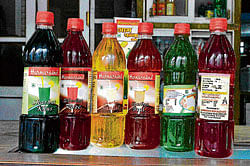
Old Delhi is well-known for its historic jewels. This shop, in the hot and congested bylanes of Khari Baoli, has quite a few jewels for real.
No, we are not referring to precious stones here but sparkling red, green, yellow
and orange sharbat bottles. They will catch your eye from a distance and the natural aroma of home-made sharbat unfailingly drift you to this shop.
Welcome to Harnarain Gokalchand - a more than 200 year old sharbat shop providing a refreshing change in the heady spicy streets of Khari Baoli. They call themselves ‘fruit preservers’ and sell everything fruity and home-made from pickles, murabbas and chutneys to glazed and crystallized fruits used in baking.
However, sharbats are their speciality and that is what they have been come to known for past two centuries now.
The fourth-generation owner of this family business – Bharat Arora informs us, “My great grandfather Lala Harnarain established this shop in 1808. At that time, this place - from Red Fort to Bara Hindu Rao Hospital was still known as Shahjanabad.
We had a very homely small manufacturing unit with only five to seven workers.
Then in 1940, my grandfather Gokalchand and his brothers split the business and the shop was named after him. Later, my father took over from him and I have been running this shop for the past 30 years now.”
“Even with a small catering then, we have served sharbats to Jawaharlal Nehru, Indira Gandhi, several CMs and even today orders are placed with us for PM’s banquets and from President’s House.
It was only in 1975, that we moved our manufacturing unit to a bigger place in Britannia Chowk in North Delhi, and have since increased the variety of our sharbats from just rose, kewra, khus and sandalwood to aam panna and bel as well.”
The reason he tells us is that these two varieties used to be made at home by women till a few years back. However, due to lack of time and patience, people have stopped making even these at home now and shops have taken over the business. “In fact, so many of our sharbat flavours have been lost like that,” he says.
“Sharbats are mainly of two kinds - fruit-based like mango and bel, and non fruit-based like rose and kewra. The latter includes herb-based sharbats like Manafshah, Nilofer, Brahmi etc. as well as dry-fruit based like thandai.
However, you would hardly hear of fruit sharbats like that of fhalsa and shahtoosh, and non-fruit ones like raat ki raani, saunf and imli now. We used to make fhalse ka sharbat till some time back, but even we have stopped it as fhalsa is a seasonal fruit and not so commonly found these days,” he informs.
Bharat is, however, hopeful of the resurrection of sharbats. “In the past few decades or so, people had given up on desi drinks and were completely sold over colas. However, I see that people are realizing the benefits of traditional coolers and coming back to nature.
This is a good sign because unlike colas, sharbats have very less preservatives, additives and synthetic colours. Also they cool the body naturally and keep the stomach fit. Herb sharbats have their own medicinal properties and they should not be lost to time and a busy life.”
Of course, for these rare sharbats come back to Old Delhi and rediscover new gastronomic jewels each time.